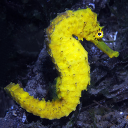Assembly
The H_comes_QL1_v1 assembly was submitted by South China Sea Institute of Oceanology, Chinese Academy of Sciences on December 2016. The assembly is on scaffold level, consisting of 60,478 contigs assembled into 37,377 scaffolds. The N50 size is the length such that 50% of the assembled genome lies in blocks of the N50 size or longer. The N50 length for the contigs is 39,546 while the scaffold N50 is 2,034,572.
Gene annotation
The tiger tail seahorse (Hippocampus comes) is a species of fish in the family Syngnathidae. It is found in India, Indonesia, Malaysia, the Philippines, Singapore, Thailand and Vietnam. Its natural habitats are subtidal aquatic beds and coral reefs. It is threatened by habitat loss.The tiger tail sea horse lives in Western Central Pacific: Malaysia, Singapore, Thailand, Vietnam, and the Philippines. It lives from 0-1.5 years in captivity and in the wild, 1–5 years. It is harmless. Its climate in water is tropical; 15°N - 1°N and Its maximum size is 18.7 cm. Its snout is 2.2 in head length; it is used to suck up food. They eat small fish, coral, small shrimp, and plankton. The most common pattern is alternating yellow and black. The tail has stripes from the belly to the tip of the tail. These sea horses are normally found in pairs on coral reefs, sponge gardens, kelp, or floating Sargassum, this species is nocturnal. The male carries the eggs in a brood pouch on their chest which holds from 1 - 2,000 eggs and the pregnancy takes from 1 to 4 weeks. It is also used for traditional Chinese medicine. Seahorse populations are thought to have been endangered in recent years by over fishing and habitat destruction. The seahorse is used in traditional Chinese medicine, and as many as 20 million seahorses may be caught each year and sold for this purpose. Import and export of seahorses has been controlled under CITES since May 15, 2004. They don't have scales as fish do, they have a tough thin skin stretched out around bony rings on their bodies. This makes them an unlikely prey for most marine animals, as they are too bony to digest. They swim upright, rather than horizontally.
The gene annotation process was carried out using a combination of protein-to-genome alignments, annotation mapping from a suitable reference species and RNA-seq alignments (where RNA-seq data with appropriate meta data were publicly available). For each candidate gene region, a selection process was applied to choose the most appropriate set of transcripts based on evolutionary distance, experimental evidence for the source data and quality of the alignments. Small ncRNAs were obtained using a combination of BLAST and Infernal/RNAfold. Pseudogenes were calculated by looking at genes with a large percentage of non-biological introns (introns of <10bp), where the gene was covered in repeats, or where the gene was single exon and evidence of a functional multi-exon paralog was found elsewhere in the genome. lincRNAs were generated via RNA-seq data where no evidence of protein homology or protein domains could be found in the transcript.
In accordance with the Fort Lauderdale Agreement, please check the publication status of the genome/assembly before publishing any genome-wide analyses using these data.
More information
General information about this species can be found in Wikipedia.
Statistics
Summary
| Assembly | H_comes_QL1_v1, INSDC Assembly GCA_001891065.1, Dec 2016 |
| Base Pairs | 493,775,940 |
| Golden Path Length | 493,775,940 |
| Annotation provider | Ensembl |
| Annotation method | Full genebuild |
| Genebuild started | May 2018 |
| Genebuild released | Jul 2018 |
| Genebuild last updated/patched | Mar 2020 |
| Database version | 115.1 |
Gene counts
| Coding genes | 20,852 |
| Non coding genes | 353 |
| Small non coding genes | 325 |
| Long non coding genes | 10 |
| Misc non coding genes | 18 |
| Pseudogenes | 21 |
| Gene transcripts | 28,809 |
Other
| Genscan gene predictions | 37,960 |
